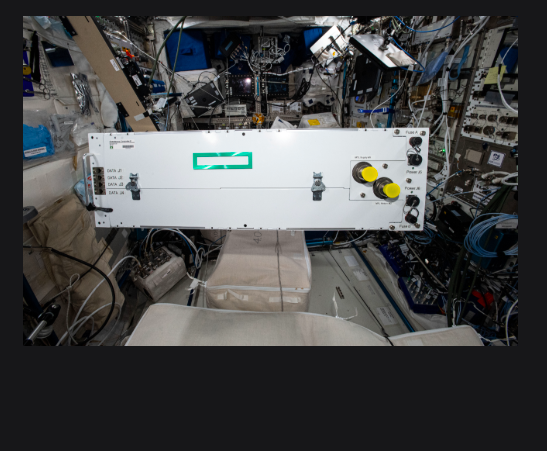Hewlett Packard Enterprise (HPE) holds 24 experiments
Since launching to the ISS a year ago, HPE Spaceborne Computer-2 has accelerated time-to-insight, from months to minutes, to advance healthcare, image processing, natural disaster recovery, 3D printing, 5G, AI and more
Bengaluru, NFAPost: Hewlett Packard Enterprise (HPE) announced that the HPE Spaceborne Computer-2 (SBC-2), the first in-space commercial edge computing and AI-enabled system to run on the International Space Station (ISS), has successfully completed 24 research experiments, accelerating time-to-insight from months and days, to minutes.
The experiments involved real-time data processing and testing of new applications to prove reliability in space as part of an effort to increase autonomy for astronauts. These experiments spanned uses cases supporting healthcare, image processing, natural disaster recovery, 3D printing, 5G, and solutions enabled by artificial intelligence.
HPE Principal Investigator, Spaceborne Computer-2, Dr. Mark Fernandez said by introducing edge computing and AI capabilities to the International Space Station with Spaceborne Computer-2, HPE have helped foster a growing, collaborative research community that shares a common goal to make scientific and engineering breakthroughs that benefit humankind, on space and here on Earth.
“We are proud of this ongoing work, which has already resulted in 24 completed experiments, from various organisations, demonstrating new possibilities for space exploration and milestones for humanity,” said HPE Principal Investigator, Spaceborne Computer-2, Dr. Mark Fernandez.
Breaking ground for edge computing and AI in space with Spaceborne Computer-2
HPE launched Spaceborne Computer-2, in collaboration with the ISS National Laboratory, to space in February 2021 and was installed on the ISS in May 2021.
The solution is comprised of HPE’s edge computing solutions, the HPE Edgeline Converged EL4000 Edge system, which provides a rugged and compact system designed to perform in harsher edge environments, such as space, and the HPE ProLiant DL360 server, a trusted, industry-standard server, for additional high-performing capabilities to target a range of workloads, including edge, HPC, AI, etc.
SBC-2 is part of a greater mission to significantly advance computing and reduce dependence on communications as humans travel farther into space to the Moon, Mars and beyond.
The solution also demonstrates potential ways astronauts can increase self-sufficiency when processing data directly on the space station, in real-time, bypassing longer latency and wait times that occur when relying on sending raw data to Earth to be processed, analyzed, and sent back to space.
Enabling faster computing and shorter download times to Earth with 20,000X speed-up
The edge computing capabilities delivered through SBC-2 also have the potential to enable astronauts and space explorers to send data to Earth, whether to be further analyzed or used in another way, at a radically compressed size and faster speed.
Previously, 1.8 GB of raw DNA sequence data took an average time of 12.2 hours just to download to Earth for initial processing. With SBC-2, researchers onboard the space station can process that same data in six minutes to gather meaningful insights, compress it to 92 KB and send it to Earth in just two seconds, representing a 20,000X speed-up.
Spaceborne Computer-2 completes 24 experiments using in-space edge computing and AI
Since its installment on the ISS, Spaceborne Computer-2 ran dozens of experiments by processing data at the edge, in real-time, for researchers with organisations developing breakthrough capabilities for space exploration such as Axiom, Cornell University, Comucore, Microsoft, NASA and Titan Space Technologies. Example experiments include:
Experiment focused on increasing human safety and self-sufficiency by using AI-enabled damage detection in astronaut gloves – Astronauts on the ISS are often on spacewalks where they repair equipment, install new instruments and upgrade features and functions on the space station.
They wear essential gloves that can experience natural erosion, along with even rips and cuts, that can present potential safety concerns. In an experiment led by NASA, HPE and Microsoft, photos and recorded video taken in space of recently worn gloves by astronauts, were processed using Spaceborne Computer-2’s AI-enabled capabilities.
The glove analyzer model, jointly developed by NASA and Microsoft, was then used to rapidly look for signs of damage on-orbit, in space. If damage is detected, an AI-annotated photo is generated in space and immediately sent to Earth, highlighting areas for further review by NASA engineers.
Automatic interpretation of satellite imagery after a disaster – NASA Jet Propulsion Laboratory observes Earth from space to study science and climate, as well as support disaster response.
Using Spaceborne Computer-2 in concert with embedded processors, NASA JPL tested several deep learning inference networks to automatically interpret remote sensed images from land and structures after a disaster.
For example, two such techniques use radar data from the UAVSAR platform to: determine flood extent, such as from a hurricane, and to determine urban building damage, such as from an earthquake. These techniques could be used onboard future spacecraft to rapidly deliver actionable products to relevant authorities to assist in disaster recovery.
Enable 3D printing
Enabling 3D printing in space with validated software – As humans look to future deep space travel, ordering supplies to repair or build new equipment from Earth will not be timely and practical.
To increase self-sufficiency by enabling additive manufacturing for humans traveling beyond low Earth orbit (LEO), Cornell Fracture Group, part of Cornell University, a leading research university, developed a modeling software that can simulate 3D printing of metal parts and even predict any failure and deformation that may result when printing in the harsh condition of space.
The software was successfully tested on Spaceborne Computer-2, validating that it can be used in space to digitally simulate a part and understand how it will perform in reality.
Expanding network capability on the ISS with a 5G core prototype – Cumucore, a private mobile network solution provider, tested its 5G core network, along with RAN emulators and other features, on Spaceborne Computer-2, to emulate current capabilities on the base station and end-user devices.
The validation demonstrated the potential to install state-of-the-art 5G capabilities on selected satellites and spacecraft to unlock a new level of communications in space. The validation also has the potential to support near future opportunities using 5G due to the rapid expansion of the commercialisation of space.
Developing software codes to calculate fuel requirements based on space travel distance — As part of HPE’s ongoing work with students worldwide to mentor and support efforts in STEM research, HPE opened up Spaceborne Computer-2 to students in India involved in Codewars, an educational community and competition for computer programming.
The projects largely focused on developing code using C++, Python and Fortran, with one involving C++ Pythagoras theorem code to calculate how much fuel is needed for given space travel distance to directly travel to without requiring refueling.
About Hewlett Packard Enterprise
Hewlett Packard Enterprise (NYSE: HPE) is the global edge-to-cloud company that helps organizations accelerate outcomes by unlocking value from all of their data, everywhere.
Built on decades of reimagining the future and innovating to advance the way people live and work, HPE delivers unique, open and intelligent technology solutions as a service.
With offerings spanning Cloud Services, Compute, High-Performance Computing & AI, Intelligent Edge, Software, and Storage, HPE provides a consistent experience across all clouds and edges, helping customers develop new business models, engage in new ways, and increase operational performance.





